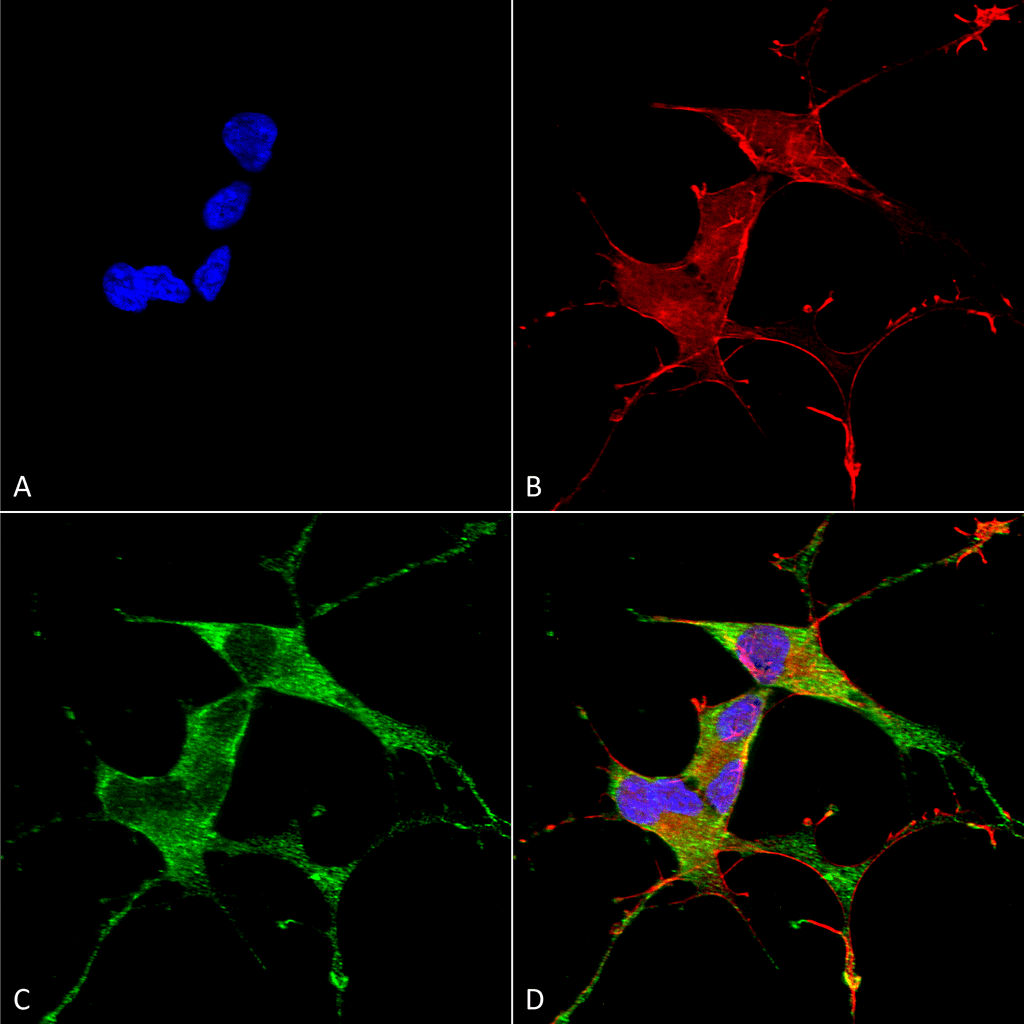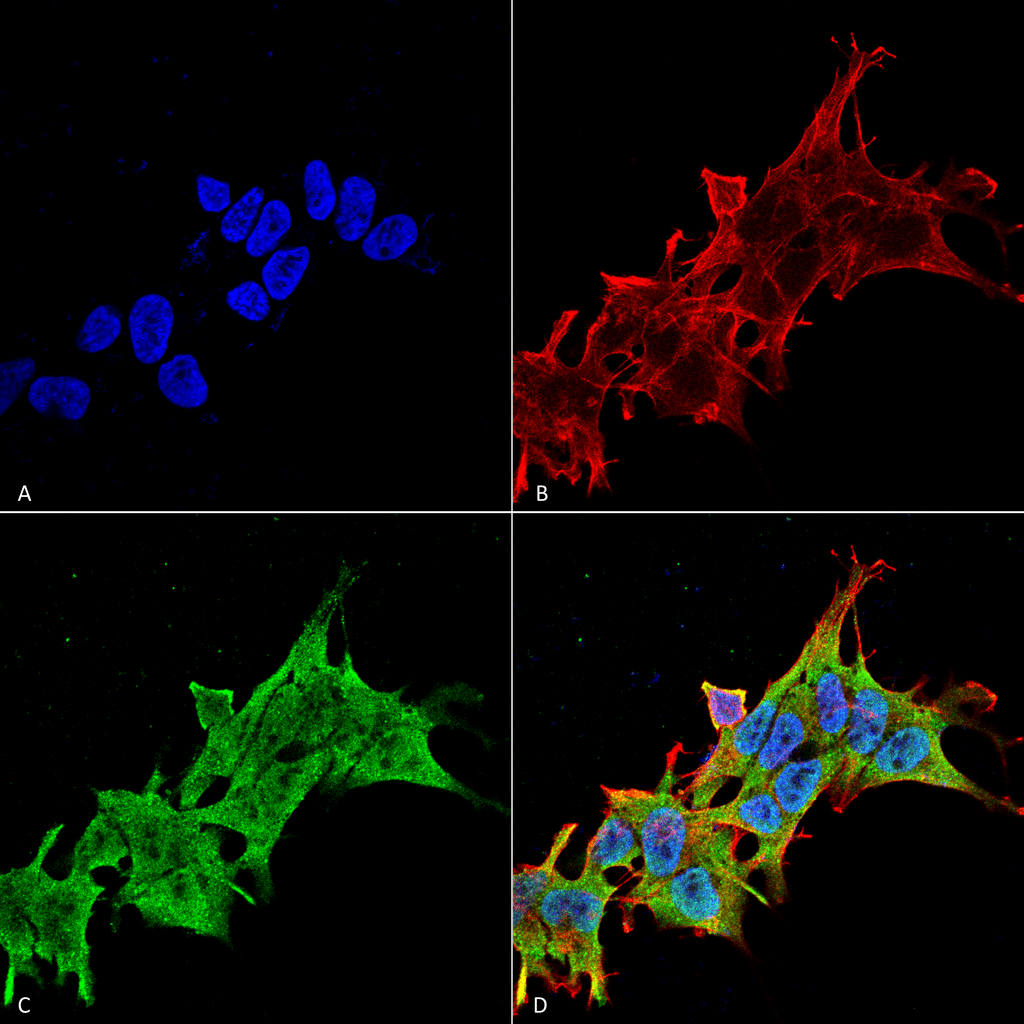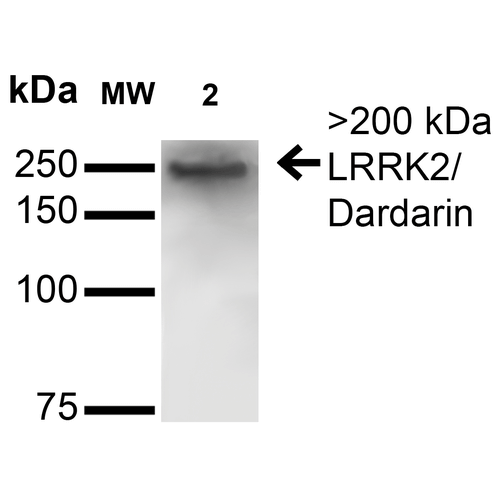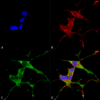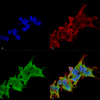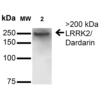Anti-Leucine-Rich Repeat Kinase 2 (LRRK2) Antibody (56582)
$466.00
SKU: 56582
Categories: Antibody Products, Neuroscience and Signal Transduction Antibodies
Overview
Product Name Anti-Leucine-Rich Repeat Kinase 2 (LRRK2) Antibody (56582)
Description Anti-Leucine-Rich Repeat Kinase 2 (LRRK2) Mouse Monoclonal Antibody
Target Leucine-Rich Repeat Kinase 2 (LRRK2)
Species Reactivity Human, Rat
Applications WB,ICC/IF
Host Mouse
Clonality Monoclonal
Clone ID S231B-34
Isotype IgG2a
Immunogen Fusion protein corresponding to aa 841-960 of human LRRK2. This sequence is 81
Properties
Form Liquid
Concentration 1.0 mg/mL
Formulation PBS, pH 7.4, 0.1% sodium azide, 50% glycerol.
Buffer Formulation Phosphate Buffered Saline
Buffer pH pH 7.4
Buffer Anti-Microbial 0.1% Sodium Azide
Buffer Cryopreservative 50% Glycerol
Format Purified
Purification Purified by Protein G affinity chromatography
Specificity Information
Specificity This antibody recognizes human and rat LRRK2.
Target Name Leucine-rich repeat serine/threonine-protein kinase 2
Target ID Leucine-Rich Repeat Kinase 2 (LRRK2)
Uniprot ID Q5S007
Alternative Names EC 2.7.11.1, EC 3.6.5.-, Dardarin
Gene Name LRRK2
Sequence Location Cytoplasmic vesicle, Perikaryon, Golgi apparatus membrane, Cell projection, axon, Cell projection, dendrite, Endoplasmic reticulum membrane, Cytoplasmic vesicle, secretory vesicle, synaptic vesicle membrane, Endosome, Lysosome, Mitochondrion outer membrane
Biological Function Serine/threonine-protein kinase which phosphorylates a broad range of proteins involved in multiple processes such as neuronal plasticity, autophagy, and vesicle trafficking (PubMed:20949042, PubMed:22012985, PubMed:26824392, PubMed:29125462, PubMed:28720718, PubMed:29127255, PubMed:30398148, PubMed:29212815, PubMed:30635421, PubMed:21850687, PubMed:23395371, PubMed:17114044, PubMed:24687852, PubMed:26014385, PubMed:25201882). Is a key regulator of RAB GTPases by regulating the GTP/GDP exchange and interaction partners of RABs through phosphorylation (PubMed:26824392, PubMed:28720718, PubMed:29127255, PubMed:30398148, PubMed:29212815, PubMed:29125462, PubMed:30635421). Phosphorylates RAB3A, RAB3B, RAB3C, RAB3D, RAB5A, RAB5B, RAB5C, RAB8A, RAB8B, RAB10, RAB12, RAB35, and RAB43 (PubMed:26824392, PubMed:28720718, PubMed:29127255, PubMed:30398148, PubMed:29212815, PubMed:29125462, PubMed:30635421, PubMed:23395371). Regulates the RAB3IP-catalyzed GDP/GTP exchange for RAB8A through the phosphorylation of 'Thr-72' on RAB8A (PubMed:26824392). Inhibits the interaction between RAB8A and GDI1 and/or GDI2 by phosphorylating 'Thr-72' on RAB8A (PubMed:26824392). Regulates primary ciliogenesis through phosphorylation of RAB8A and RAB10, which promotes SHH signaling in the brain (PubMed:29125462, PubMed:30398148). Together with RAB29, plays a role in the retrograde trafficking pathway for recycling proteins, such as mannose-6-phosphate receptor (M6PR), between lysosomes and the Golgi apparatus in a retromer-dependent manner (PubMed:23395371). Regulates neuronal process morphology in the intact central nervous system (CNS) (PubMed:17114044). Plays a role in synaptic vesicle trafficking (PubMed:24687852). Plays an important role in recruiting SEC16A to endoplasmic reticulum exit sites (ERES) and in regulating ER to Golgi vesicle-mediated transport and ERES organization (PubMed:25201882). Positively regulates autophagy through a calcium-dependent activation of the CaMKK/AMPK signaling pathway (PubMed:22012985). The process involves activation of nicotinic acid adenine dinucleotide phosphate (NAADP) receptors, increase in lysosomal pH, and calcium release from lysosomes (PubMed:22012985). Phosphorylates PRDX3 (PubMed:21850687). By phosphorylating APP on 'Thr-743', which promotes the production and the nuclear translocation of the APP intracellular domain (AICD), regulates dopaminergic neuron apoptosis (PubMed:28720718). Independent of its kinase activity, inhibits the proteosomal degradation of MAPT, thus promoting MAPT oligomerization and secretion (PubMed:26014385). In addition, has GTPase activity via its Roc domain which regulates LRRK2 kinase activity (PubMed:18230735, PubMed:26824392, PubMed:29125462, PubMed:28720718, PubMed:29212815). {PubMed:17114044, PubMed:18230735, PubMed:20949042, PubMed:21850687, PubMed:22012985, PubMed:23395371, PubMed:24687852, PubMed:25201882, PubMed:26014385, PubMed:26824392, PubMed:28720718, PubMed:29125462, PubMed:29127255, PubMed:29212815, PubMed:30398148, PubMed:30635421}.
Research Areas Neuroscience
Background Leucine-rich repeat kinase 2 (LRRK2), also known as dardarin, is an enzyme that in humans is encoded by the PARK8 gene. The protein is present largely in the cytoplasm but also associates with the mitochondrial outer membrane. Mutations in this gene have been associated with Parkinson's disease type 8 and Crohn's disease which suggests that these two diseases share a common pathway. Expression of mutant LRRK2 induced apoptotic cell death in neuroblastoma cells and in mouse cortical neurons.
Application Images




Description Immunocytochemistry/Immunofluorescence analysis using Mouse Anti-LRRK2/Dardarin Monoclonal Antibody, Clone S231B-34 (56582). Tissue: Neuroblastoma cells (SH-SY5Y). Species: Human. Fixation: 4% PFA for 15 min. Primary Antibody: Mouse Anti-LRRK2/Dardarin Monoclonal Antibody (56582) at 1:100 for overnight at 4°C with slow rocking. Secondary Antibody: AlexaFluor 488 at 1:1000 for 1 hour at RT. Counterstain: Phalloidin-iFluor 647 (red) F-Actin stain; Hoechst (blue) nuclear stain at 1:800, 1.6mM for 20 min at RT. (A) Hoechst (blue) nuclear stain. (B) Phalloidin-iFluor 647 (red) F-Actin stain. (C) LRRK2/Dardarin Antibody (D) Composite.

Description Immunocytochemistry/Immunofluorescence analysis using Mouse Anti-LRRK2/Dardarin Monoclonal Antibody, Clone S231B-34 (56582). Tissue: Neuroblastoma cell line (SK-N-BE). Species: Human. Fixation: 4% Formaldehyde for 15 min at RT. Primary Antibody: Mouse Anti-LRRK2/Dardarin Monoclonal Antibody (56582) at 1:100 for 60 min at RT. Secondary Antibody: Goat Anti-Mouse ATTO 488 at 1:100 for 60 min at RT. Counterstain: Phalloidin Texas Red F-Actin stain; DAPI (blue) nuclear stain at 1:1000, 1:5000 for 60min RT, 5min RT. Localization: Cytoplasm . Magnification: 60X. (A) DAPI (blue) nuclear stain. (B) Phalloidin Texas Red F-Actin stain. (C) LRRK2/Dardarin Antibody. (D) Composite.

Description Western Blot analysis of Rat Brain Membrane showing detection of >200 kDa LRRK2/Dardarin protein using Mouse Anti-LRRK2/Dardarin Monoclonal Antibody, Clone S231B-34 (56582). Lane 1: Molecular Weight Ladder. Lane 2: Rat Brain Membrane. Load: 15 µg. Block: 2% BSA and 2% Skim Milk in 1X TBST. Primary Antibody: Mouse Anti-LRRK2/Dardarin Monoclonal Antibody (56582) at 1:200 for 16 hours at 4°C. Secondary Antibody: Goat Anti-Mouse IgG: HRP at 1:1000 for 1 hour RT. Color Development: ECL solution for 6 min in RT. Predicted/Observed Size: >200 kDa.
Handling
Storage This product is stable for at least one (1) year at -20°C.
Dilution Instructions Dilute in PBS or medium that is identical to that used in the assay system.
Application Instructions Immunoblotting: use at 1-5ug/mL. A band of >200kDa is detected.
Immunofluorescence: use at 10ug/mL.
These are recommended concentrations.
Endusers should determine optimal concentrations for their application.
Immunofluorescence: use at 10ug/mL.
These are recommended concentrations.
Endusers should determine optimal concentrations for their application.
References & Data Sheet
Data Sheet  Download PDF Data Sheet
Download PDF Data Sheet
 Download PDF Data Sheet
Download PDF Data Sheet

